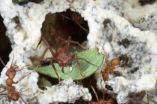(Press-News.org) June 30, 2011 – The development of agriculture was a significant event in human cultural evolution, but we are not the only organisms to have adopted an agricultural way of life. In a study published online today in Genome Research (www.genome.org), researchers have sequenced the genome of a fungus farming leaf-cutting ant, revealing new insights into the genetics and molecular biology behind this unusual lifestyle.
Found in Central and South America as well as the southern United States, leaf-cutting ants have evolved a symbiotic relationship with fungus. By breaking down leaves into mulch, the ants help the fungus to grow special structures for large societies of ants to feed upon.
Since being recognized as a new Panamanian species about 15 years ago, much has been learned about the biology of the leaf-cutting ant Acromyrmex echinatior, but the genetic basis of their farming lifestyle remained largely unknown. In this report, an international team of researchers has sequenced the genome of A. echinatior, and by comparison to other ant and insect genomes, identified genomic clues to the evolution of fungus farming behavior.
The authors noted that one of the most interesting findings in the genome of this leaf-cutting ant was that there are more genes in two particularly noteworthy gene families. "Based on their function in other organisms, we expect them to be involved in mating system adaptations and symbiotic food processing with the fungus," said Dr. Sanne Nygaard of the Copenhagen Centre for Social Evolution, co-lead author of the study.
Nygaard explained that these findings are especially fascinating because known evolutionary changes in the reproductive biology and farming lifestyle of these ants can now be linked to specific genomic features.
The authors also noted a particularly surprising result when comparing genes coding for neuropeptides, the small molecules that drive many biological processes, between the leaf-cutting ant and the sequenced genes of other ants with varied habitats, diets, and behaviors. They expected that differences in neuropeptide genes would be pronounced, but they found just the opposite.
"An identical set of neuropeptide genes is present in all the ant genomes we examined," said Nygaard, "showing that these genes are remarkably conserved." The authors suggest that the neuroendocrinology of all ants may have a very similar make-up, going back to the dawn of social evolution in the ancestor of all present ants.
"We are as yet only scratching the surface of the fascinating adaptations that will likely be revealed in the coming years," added Dr. Jacobus Boomsma, Director of the Copenhagen Centre for Social Evolution and co-senior author of the report, explaining that the genome sequence and analysis performed here will set the stage for further insights into the biology of social behavior.
INFORMATION:
Scientists from the University of Copenhagen (Copenhagen, Denmark), BGI-Shenzhen (Shenzhen, China), the University of Lausanne (Lausanne, Switzerland), and the Natural History Museum of Denmark (Copenhagen, Denmark) contributed to this study.
This work was supported by the Danish National Research Foundation, the Danish Research Agency, the Novo Nordisk Foundation, and the Swiss National Science Foundation.
Media contacts:
The authors are available for more information by contacting:
Dr. Sanne Nygaard, Centre for Social Evolution, University of Copenhagen: sanne@bio.ku.dk; cell phone +45 30 95 59 01
Dr. Guojie Zhang, Scientific Department, BGI-Shenzhen: zhanggj@genomics.org.cn; cell phone +86 134 2288 3247
Prof. Jacobus J. Boomsma, Centre for Social Evolution, University of Copenhagen: jjboomsma@bio.ku.dk; cell phone +45 20436771
Interested reporters may obtain copies of the manuscript from Peggy Calicchia, Administrative Assistant, Genome Research (calicchi@cshl.edu; +1-516-422-4012).
About the article:
The manuscript will be published online ahead of print on Thursday, June 30, 2011. Its full citation is as follows:
Nygaard S, Zhang G, Schiøtt M, Li C, Wurm Y, Hu H, Zhou J, Ji L, Qiu F, Rasmussen M, Pan H, Hauser F, Krogh A, Grimmelikhuijzen CJP, Wang J, Boomsma JJ. The genome of the leaf-cutting ant Acromyrmex echinatior suggests key adaptations to advanced social life and fungus farming. Genome Res doi: 10.1101/gr.121392.111.
About Genome Research:
Launched in 1995, Genome Research (www.genome.org) is an international, continuously published, peer-reviewed journal that focuses on research that provides novel insights into the genome biology of all organisms, including advances in genomic medicine. Among the topics considered by the journal are genome structure and function, comparative genomics, molecular evolution, genome-scale quantitative and population genetics, proteomics, epigenomics, and systems biology. The journal also features exciting gene discoveries and reports of cutting-edge computational biology and high-throughput methodologies.
About Cold Spring Harbor Laboratory Press:
Cold Spring Harbor Laboratory is a private, nonprofit institution in New York that conducts research in cancer and other life sciences and has a variety of educational programs. Its Press, originating in 1933, is the largest of the Laboratory's five education divisions and is a publisher of books, journals, and electronic media for scientists, students, and the general public.
Genome Research issues press releases to highlight significant research studies that are published in the journal.
Fungus farming ant genome reveals insight into adaptation of social behavior
2011-06-30
ELSE PRESS RELEASES FROM THIS DATE:
Study shows 20 percent reduction in lung cancer mortality with low-dose CT vs chest X-ray
2011-06-30
Scientists have found a 20 percent reduction in deaths from lung cancer among current or former heavy smokers who were screened with low-dose helical computed tomography (CT) versus those screened by chest X-ray. The primary research results from the National Lung Screening Trial (NLST) were published online today in the New England Journal of Medicine.
This article provides a more extensive analysis of the data originally reported in November 2010 while providing additional data to the public and research community without barriers to access. Sponsored by the National ...
Joe Jedlowski Makes Significant Donation to Alzheimer's Association
2011-06-30
Joe Jedlowski is pleased to announce a significant donation made to the Alzheimer's Association. This donation will help in many aspects when it comes to research and treatment of this detrimental disease. Joe Jedlowski, who is a prominent executive throughout the senior living field, has firsthand knowledge of the effects that Alzheimers has on individuals and their families.
As Regional Vice President of Atria Senior Living Group, Joe was affiliated with many influential groups and organizations within the New Jersey community. In addition to monetary donations, he ...
The Cancer Genome Atlas completes detailed ovarian cancer analysis
2011-06-30
An analysis of genomic changes in ovarian cancer has provided the most comprehensive and integrated view of cancer genes for any cancer type to date. Ovarian serous adenocarcinoma tumors from 500 patients were examined by The Cancer Genome Atlas (TCGA) Research Network and analyses are reported in the June 30, 2011, issue of Nature.
Serous adenocarcinoma is the most prevalent form of ovarian cancer, accounting for about 85 percent of all ovarian cancer deaths. TCGA researchers completed whole-exome sequencing, which examines the protein-coding regions of the genome, ...
Mr. Dimitri Snowden Announces the Launch of His Personal New Website
2011-06-30
Dimitri Snowden announces the launch of his new website, www.DimitriSnowden.com. The site will be a virtual hub, showcasing Dimitri's online activities and linking his business and personal pursuits in one easy to find location. The new website details Dimitri Snowden's passion for mixed martial arts (MMA), robotics, racing, the environment, and his strategic consulting firm, ion360. The consulting firm specializes in delivering compelling outcomes using clever strategy and smart technology platforms.
The newly-launched website states that Dimitri Snowden, within the ...
Lung cancer screening trial shows screening with CT scans reduces lung cancer deaths
2011-06-30
Philadelphia — Results of the National Lung Screening Trial (NLST) published online in the June 30 New England Journal of Medicine report a twenty percent reduction in lung cancer deaths among study participants who were screened with low-dose helical computed tomography (CT) versus those screened with chest X-ray. Conducted by the American College of Radiology Imaging Network (ACRIN) and the National Cancer Institute's Lung Screening Study Group, the NLST enrolled 53,000 current and former heavy smokers aged 55 to 74 at 33 sites across the United States.
Lung cancer ...
UCSF-led team decodes evolution of skin and ovarian cancer cells
2011-06-30
A team of researchers led by scientists at the University of California, San Francisco has developed a way to uncover the evolution of human cancer cells, determining the order in which mutations emerge in them as they wend their way from a normal, healthy state into invasive, malignant masses.
The work may give doctors a new way to design diagnostics for detecting the signs of early cancers, when they are generally more treatable than in their later stages.
This approach relies on teasing apart the DNA of cancer cells, and it is something like genetic archeology. ...
Betting on good luck and 4-leaf clovers
2011-06-30
Research led by the University of Cambridge has found a link between impulsivity and flawed reasoning (such as believing in superstitious rituals and luck) in problem gamblers.
Studying compulsive gamblers who were seeking treatment at the National Problem Gambling Clinic, the researchers found that those gamblers with higher levels of impulsivity were much more susceptible to errors in reasoning associated with gambling, such as superstitious rituals (e.g. carrying a lucky charm) and explaining away recent losses (e.g. on bad luck or 'cold' machines).
The findings ...
How safe is mist netting? First large-scale study into bird capture technique evaluates the risks
2011-06-30
Capturing birds using mist nets to study behaviour, movement or the demographics of a species is one of the most common research techniques in ornithology, yet until now there have been no large scale studies into the risks mist nets pose to birds. Writing in the British Ecological Society's Methods in Ecology and Evolution researchers from California used a dataset of over 345,000 records to evaluate the risks of mist netting.
The research, led by Erica Spotswood from the University of California at Berkeley, used data from organisations across the United States and ...
Drink-fueled memory blackouts among students predict future injury risk
2011-06-30
The higher the number of drink fuelled memory blackouts a student experiences, the greater is his/her risk of sustaining a future injury while under the influence, reveals research published online in Injury Prevention.
Memory blackouts refer to the inability to recall events; they do not refer to loss of consciousness as a result of drinking too much. Research indicates that alcohol alters nerve cell communication in the hippocampal region of the brain, which affects memory formation.
Hazardous drinking - and its consequences - "are pervasive on college campuses," ...
Junior doctors clueless about what to do during major incidents
2011-06-30
Junior doctors have no idea what they should be doing when a major incident, such as a terrorist attack or transport disaster, occurs, reveals research published in the online journal BMJ Open.
This knowledge gap could be critical, says the author, especially as the UK's current terrorism threat level is classified as "severe," meaning that a terrorist attack is highly likely.
The Department of Health defines a major incident as "any event whose impact cannot be handled within routine service arrangements." It involves special procedures by one or more of the emergency ...


